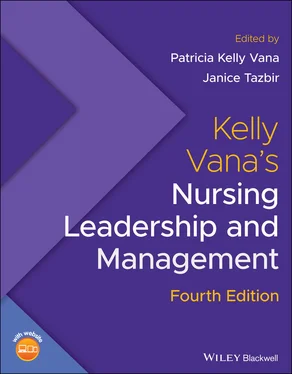Many nursing associations addresses safety, high reliability, or one or more of the five components of HROs. For example, the American Nurses Association identified the Culture of Safety as their focus for 2016. They focused on a different theme each month to explore the benefits of a collaborative commitment to safety, and how to achieve it (ANA, 2016). The American Association of periOperative Nurses (2018) uses “Safe Surgeries Together” as their tagline. Their website includes publications on many topics, including patient and worker safety, perioperative safety, medication safety, radiation safety, surgical smoke safety, sharps safety, and product and equipment safety. The Association of Women's Health, Obstetric and Neonatal Nurses' website (2018) includes a variety of educational modules designed to improve safety for obstetric and neonatal patients.
Designation by the American Nurse's Credentialing Center(ANCC) as a Magnet™ organization denotes nursing excellence and is factored into payer reimbursement and recognition (ANCC, 2017). The components of the Magnet Recognition Program ®are congruent with the HRO concepts. The Magnet components include Transformational Leadership; Structural Empowerment; Exemplary Professional Practice; New Knowledge, Innovations and Improvements; and Empirical Outcomes. The original Forces of Magnetism emphasized structure and process. The current Magnet Model recognizes that an excellent infrastructure must result in positive outcomes in order to create a culture of excellence and innovation. Safety is a main component of a culture of excellence.
The Transformational Leadership component of the Magnet Model requires strong advocacy and support for staff and patients by all nursing leaders. The CNO must be positioned to effectively influence other executive stakeholders, including the board of directors. In a Magnet‐designated hospital, the CNO is an active leader in creating an HRO by working with the hospital's executive team to establish a strategic plan for quality and safety. These strategic goals support the organization's commitment to zero major quality failures.
Evidence from the Literature
Source: Adapted from Jeffs, L., Baker, G. R., Taggar, R., Hubley, P., Richards, J. et al. (2018). Attributes and actions required to advance quality and safety in hospitals: Insights from nurse executives. Nursing Leadership , 31 (2), 20‐31. doi:10.12927/cjnl.2018.25606
Discussion:The article describes qualitative research conducted to explore nurse executives' understanding of and engagement with patient safety and quality improvement. Three themes emerged: 1) being a strategic and system thinker while possessing emotional intelligence and influencing staff; 2) building credibility and relationships with point‐of‐care staff, board of directors, and the leadership team; and 3) creating a culture of safety and high reliability.
Implications for Practice.Study findings are helpful for nurse leaders at all levels to enhance their knowledge, attitudes, and skills in quality and safety.
The Structural Empowerment component of Magnet addresses the need to create structures and processes that allow nurses to practice safely and effectively. For example, one source of evidence related to Structural Empowerment calls for clinical nurse involvement in interprofessional decision‐making groups at the organizational level. Five of the 13 Structural Empowerment sources of evidence address nursing's role related to quality and safety. Both the Transformational Leadership and Structural Empowerment components of Magnet require the active engagement of nurses.
The Exemplary Professional Practice component of Magnet indicates that “achievement of exemplary professional practice is grounded in a culture of safety, quality monitoring, and quality improvement” (ANCC, 2017, p. 40) and that “[n]urses participate in safety initiatives that incorporate national best practices” (ANCC, 2017, p. 41). Many of the Exemplary Professional Practice sources of evidence require documentation of safe nursing practices. For example, all organizations that provide inpatient care are required to report on two nurse‐sensitive clinical indicators: patient falls with injury and hospital‐acquired pressure injury, stages 2 and above. The hospitals must report two additional measures from a list that includes: central line‐associated blood stream infection, catheter‐associated urinary tract infection, Clostridium difficile , Methicillin‐resistant Staphylococcus aureus , venous thromboembolism, peripheral intravenous infiltrations, physical and sexual assault, and device‐related hospital‐acquired pressure injury. Two ambulatory indicators must also be reported. The performance on each of the six indicators must exceed the mean or median value for the majority of units the majority of the time to meet Magnet standards. Other sources of evidence require examples of nurse partnership with patients and/or families to influence change in the organization; and improved outcomes related to the professional practice model, interprofessional collaborative plan of care, interprofessional quality improvement activity, interprofessional education, and clinical nurse involvement in the evaluation of patient safety data at the unit level. Last, nurse safety is also addressed within the Exemplary Professional Practice component. Organizations must provide an example of an improved workplace safety outcome for nurses specific to workplace violence.
The New Knowledge, Innovations and Improvements component of Magnet requires nurses to use evidence and innovation for safe, high‐quality care. Last, the Empirical Outcomes component of Magnet requires the organization to continually assess and monitor a variety of indicators for nursing leadership and clinical practice. Sustained quality performance on empirical outcomes will move an organization on the journey to becoming an HRO.
Magnet is a continuous journey that creates a culture that strives to improve outcomes centered on safety, quality, and service for patients and nurses. As nurses lead the care delivery environment, they are at the sharp point of creating a healthy environment and delivering safe quality care which are the pillars of a Magnet organization.
Wendy Tuzik Micek, PhD, RN, NEA‐BC
Director Nursing Science and Magnet Program Director
Advocate Children's Hospital
Oak Lawn, IL
Interprofessional Organizations
Participation in interprofessional organizations can also assist nurse leaders in their quest to become HROs. Organizations include the IHI, The Institute for Safe Medication Practices(ISMP), National Patient Safety Foundation, National Quality Forum(NQF), and Patient Safety Organizations.
Institute for Healthcare Improvement
The work of the IHIbegan as part of a demonstration project to redesign health care into a system without errors, waste, delay, and unsustainable costs. IHI works with health systems, countries, and other organizations on improving quality, safety, and value in health care. They use a science of improvement approach, characterized by combining expert subject knowledge with improvement methods and tools. This interprofessional approach draws on clinical science, systems theory, psychology, statistics, and other fields. IHI's methodology is based on the work of W. Edwards Deming, who taught that organizations can increase quality and simultaneously reduce costs (Institute for Healthcare Improvement, 2018). The IHI Model for Improvement asks three questions: 1) What are we trying to accomplish; 2) How will we know that a change is an improvement; and 3) What changes can we make that will result in improvement? As seen in Figure 4.8, the model then employs Plan‐Do‐Study‐Act(PDSA) cycles for small, rapid‐cycle tests of change (Institute for Healthcare Improvement, 2018).
Читать дальше












